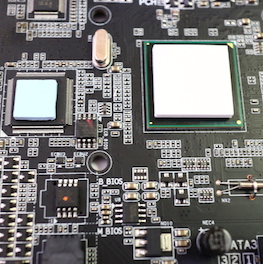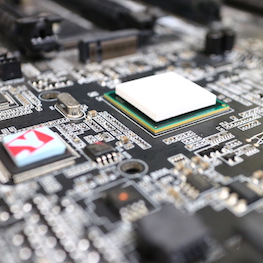Senturi is now an authorized distributor for LiPOLY
LiPOLY continuously innovates thermal interface materials (TIMs) to meet the demands of the rapidly changing technological landscape. Find out more and request a quote today.
Thermal Solutions For 5G & EV
Over the past decade, LiPOLY has developed Thermal Pads, Thermal Pastes, Thermal Greases, Gap Fillers, Thermal Tapes and Insulator materials for companies working in Computer, Storage, Gaming, Datacom Infrastructure, Automotive Electronics, Lighting Equipment, Power and Industrial Automation. LiPOLY TIM’s have been designed into thousands of applications for some of the largest electronic companies in the world. We listen to our customers’ needs and develop thermal solutions that meet our customers’ specific design requirements. Our customers come to us because we deliver innovative and reliable thermal interface solutions.
LiPOLY Thermal Interface Materials for 5G & EV have:
- Low thermal impedance
- High thermal conductivity
- Low dielectric constant
- EMI absorption
- Stronger adhesion / Soft Material
- Great compliance and conformability
- Ease of application
- Consistent reliability




Frequently Asked Questions
Thermal Putty vs Thermal Grease vs Two-Part Fast Curing Thermal Conductive Gel
Thermal Grease is a thermally conductive compound designed to be used as an interface between heat sources and a cooler. The main purpose of thermal grease is to eliminate air gaps or micro spaces between the heat sink and heat source and maximize heat transfer between a heat source and heat sink. The top surface of a heat source is not perfectly flat. There tend to be microscopic grooves or uneven surfaces which create air gaps between the microprocessor and heat sink, reducing the effectiveness of the heat transfer. Thermal grease keeps electronics at a lower temperature with low thermal resistance and increases processability. It also features of low bond line thickness of 10μm and low viscosity of 900 pa.s.
Applications:
- CPU and chip coolers
- Switching power supplies
- LED appliances
- Between any heat generating component and heatsink
Thermal Putty is a tolerance-filled, thermally conductive putty that maintains high compressibility with low stress, high reliability, and will not flow vertically. The high deformation material can fill small gaps closely, cover high tolerance, overcome issues with overflow and solve drying problems to increase the thermal conductivity. Thermal putty is a perfect thermal conductive compound replacement for thermals pads to successfully remove manufacturing tolerances because of its flexible characteristics. Thermal putty can be used in various electronic components with design gaps of 0.1mm-3.0mm. Available for dispensing machine.
Applications:
- Notebook computers
- Electric Vehicle
- TV hardware
- Wireless communication hardware
- High-speed mass storage drives
- Set-top box
- IP CAM
Two-Part Fast Curing Thermal Conductive Gel is a two-part liquid gap filler for contacting different heights of design gap between the heat source and cooler with a low-pressure application. This gel can be fast cured at room temperature or elevated temperature and provide high thermal conductivity with low thermal impedance. With its fast-curing feature, it also offers high reworkability as well as high reliability. It is the best solution for different heights of heat sources in one specific area. Available for dispensing machine.
Applications:
- Between CPU and heat sink
- Between a component and heat sink
- Power supplies
- High speed mass storage drives
- Telecommunication hardware
Quick Summary – Grease vs Putty vs Two-Part
Thermal Grease (Air Gaps Elimination & Low Bond Line Thickness)
- Performance ★★★★
- Operation ★★★
- Reliability ★★★
- Dispense Method: Manual, dispensing machine, screen printing
Thermal Putty (Automation & High Tolerance)
- Performance ★★★
- Operation★★★★
- Reliability ★★★★
- Dispense Method: Manual, dispensing machine, stencil printing
Two-Part Fast Curing Thermal Conductive Gel (Automation & Curable)
- Performance ★★★
- Operation ★★★★
- Reliability ★★★★
- Dispense Method: Manual, dispensing machine
What are thermal interface materials (TIMs)?
Thermal Interface Materials (TIMs) or Thermal Compounds, is a general reference used to describe any material used between two parts to improve the thermal transfer between those two parts. A thermal interface material (TIM) is inserted between the heat source and the heat dissipation device (e.g. a heat sink). TIMs are designed to fill in small air gaps found between the heat source and heat dissipation device heatsink (e.g. a heat sink). TIMs provide improved heat transfer, lower thermal resistance, and overall better cooling of the electronic products.

Why are thermal interface materials (TIMs) important?
With a rise in consumer demand for smaller, faster electronic devices, the challenges associated with thermal management have become more intense. Thermal interface materials play a crucial role in maintaining the life and reliability of our electronic devices. Thermal interface materials are used to eliminate small air gaps from the interface by conforming to uneven surfaces, helping to reduce the working temperature of the heat source while transfer energy away from the heat source.
What are the applications?
- Between an IC and a heat sink or chassis.
- Between a semiconductor and heat sink
- CD-ROM/DVD cooling
- Heat pipe assemblies
- RDRAM memory modules
- DDR SDRAM
- Hard drive cooling
- Power supply
- IGBT modules
- Signal amplifiers
- Between other heat-generating devices and chassis
What types of thermal interface materials are there?
- Thermal Pad
- Thermal Tape
- Thermal Adhesive
- Thermal Putty
Thermal Grease vs Thermal Pad?
Thermal grease is a thermally conductive compound designed to be used as an interface between heat sinks and heat sources. The main purpose of thermal grease is to eliminate air gaps or micro spaces between the heat sink and heat source. The top surface of a heat source is not perfectly flat. There tend to be microscopic grooves or uneven surfaces which create air gaps between the microprocessor and heat sink, reducing the effectiveness of the heatsink. Thermal grease maximizes heat transfer between a heat source and heat sink.
Gap fillers are a specific type of interface material, designed to form various gaps within a component. Thermal gap fillers are well designed to form and fill variation in gaps between one application and another. Thermal gap fillers come in die-cut preforms making them easy-to-handle during the application process.
What is thermal impedance?
This is the measure of the total resistance to the flow of heat from a hot surface through an interface material into a cold surface. Thermal impedance is measured according to the ASTM D5470 test method.
What is the thermal conductivity of thermal interface materials (TIMs)?
Thermal impedance data measured according to ASTM D5470 can be used to calculate the thermal conductivity of an interface material. To read more on ASTM D5470, please visit: www.astm.org
What is compression force and why is it important?
By increasing the compression force on a thermal pad, you increase the performance of the material by lowering the contact resistance and lowering the stress on the pad. Gap fillers require some force to reduce the contact resistance between heat source-TIM-heat sink. We recommend a minimum amount of compression to ensure good thermal contact. Compression will vary by product.
What is dielectric breakdown?
This is a measure of how much voltage differential a material can withstand under a specific set of test conditions. This property is usually measured using ASTM D149 where a test specimen is subjected to ramped alternating current voltage such that dielectric failure is reached within twenty seconds after the start of the test.
Is the materials thickness important?
Yes, the thickness of your TIM is important to the overall performance of the material. It’s important to consider the compression force applied to the TIM, the thermal resistance of the TIM, and the resilience of the TIM. If the TIM is too thick and lacks sufficient compression force, the material will not perform to its fullest capability.
How do we measure material hardness?
We use the Durometer scale, which is an international standard that provides an industrial measurement of Shore hardness of materials. ASTM D2240 durometers allow for a measurement of the initial hardness or the indentation hardness after a given period of time.

What factors should I consider when choosing a time?
- Thermal Conductivity
- Hardness
- Gap Size
- Compression force
- Dielectric Requirement
- Thermal Resistance
- Dimensions
How are the materials provided?
While we offer sheets and die-cut parts, we encourage our customers to talk to use about die-cut parts. Our in-house die-cutting services ensure that each part passes our intensive QC check.
What is the shelf life of a gap pad?
The shelf life for gap Pads is one (1) year from date of manufacturing. For Gap Pad with adhesive, the shelf life is six (6) months from the date of manufacture. After these dates, inherent tack and adhesive properties should be reapplied. The Gap Pad material long-term stability is not the limiter on the shelf-life; it is related to the adhesion or “age up” of the Gap Pad to the liner. Or in the case of a Gap Pad with adhesive, the shelf life is determined by how the adhesive ages up to the removable liner.
